A few months ago, The Will To Hunt had several drawings for Muddy Outdoors Products. We won one of those drawings for a Tree Sledge. We wanted to try it out and give it a review.
Upon opening the Tree Sledge, you'll notice the solid feel from it's one-piece construction. The magnet built in to the slot on the backside of the Sledge secures tree steps nicely and it does not feel as though a step may slip out. The sheath is a nice touch as you usually have your hands full when setting up stands. The bright orange, although it is Muddy's signature color is perfect should you drop the Sledge while setting up a stand as it will stand out from all foliage and underbrush. One addition I might suggest after using the Tree Sledge is some non-slip construction on the handle, whether rubber, athletic grip-tape, or otherwise, as you will typically be sweating while setting up stands in the warmer months and it will prevent possible slipping of the Sledge in your grip (we did not experience an issue with this, just an item of note).
In testing the Tree sledge, we used Ameristep screw-in tree steps. The tree we chose to perform the review on is a Scrub Oak. Native to Oklahoma and extremely tough wood, it seemed only right to test the Sledge on the toughest tree we commonly set stands in. Upon swinging the Sledge at the tree, we did notice some bounce back of the step. This appeared to be due to the toughness of the type of tree chosen. After a few swings, it became apparent the step was not seating itself deep enough to start to screw in. Had the step been sharper, or the tree not as hard, it would have seated just fine. I did grab a hammer to assist in digging the step into the tree. With the sledge in place, my fingers were safely out of the way of the hammer and it gave a larger surface to hit versus the step itself. After a few light taps, I was able to use the Tree Sledge to wrench the step into the tree without an issue. The leverage the Tree Sledge provides is great and it saves your hands a lot of abuse while getting the job done quickly. I look forward to putting this tool to a lot of use this Spring and Summer as we hang new stands and reposition our current ones.
We did a video review so that you can see it in action.
Monday, November 26, 2012
Friday, November 16, 2012
Completed Euro Mount with Step-by-Step Instructions
I got this great 7 point on public land November 4th at 35 yards with my bow and decided to do my own euro mount to save money and take on a project I've wanted to complete for some time now.

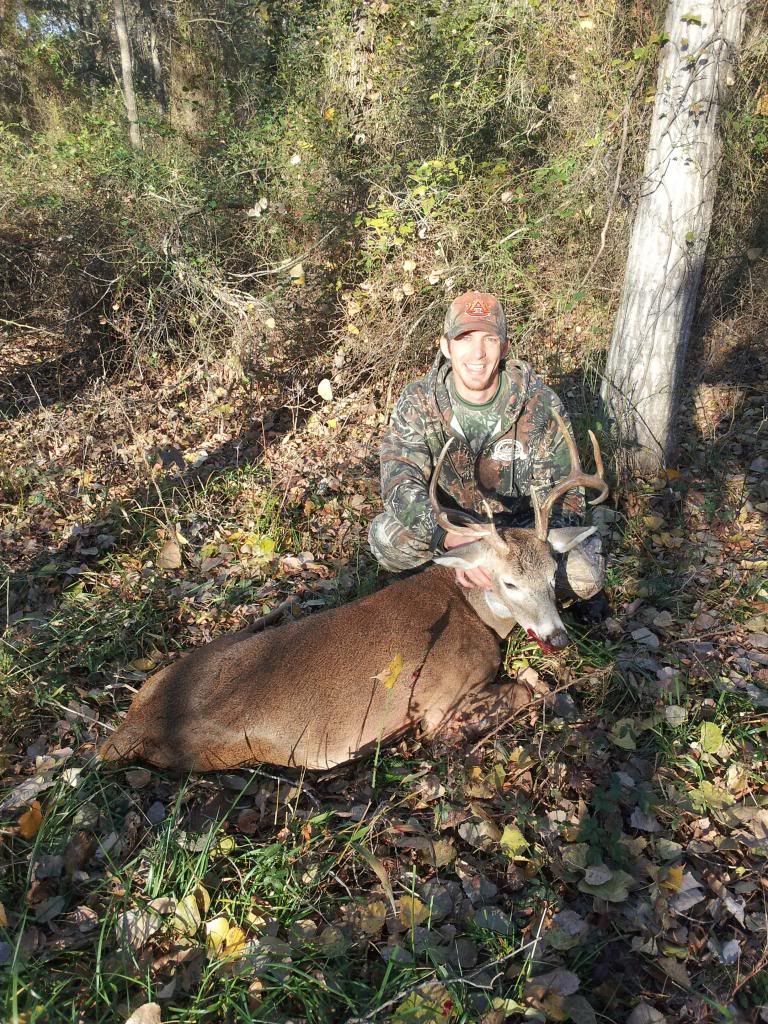
I started by skinning the head within a few hours of the kill. With the muscles and skin still warm, it was pliable and much easier to work with and remove. I used a filet knife to help skin it out. The nose area is tricky as it's mostly cartilage and easily cut. The same with the eye sockets, so be careful what you trim. I nicked mine up pretty good as I was a bit too aggressive with the trimming. The eyeballs are a pain, but with a screwdriver, you can ease them out a bit, then make your cuts around them with the filet knife to remove them. The more meat that is removed now will make your life easier later.
After skinning the head.
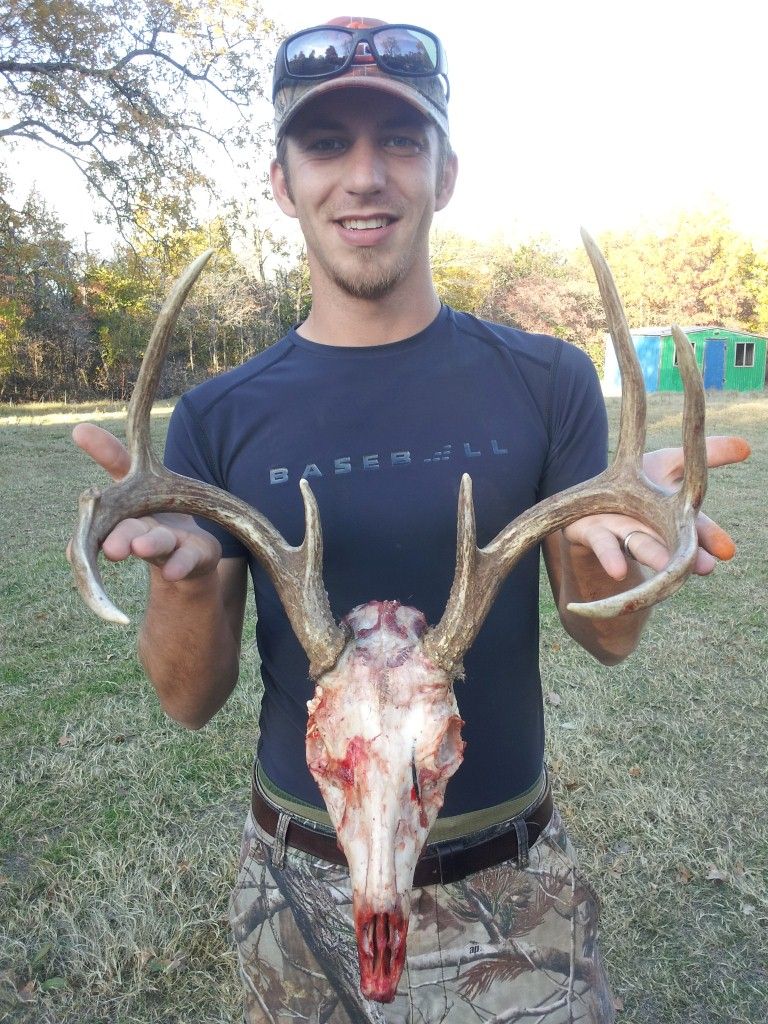
I filled a 5 gallon bucket with just tap water and soaked the skull for 24 hours.
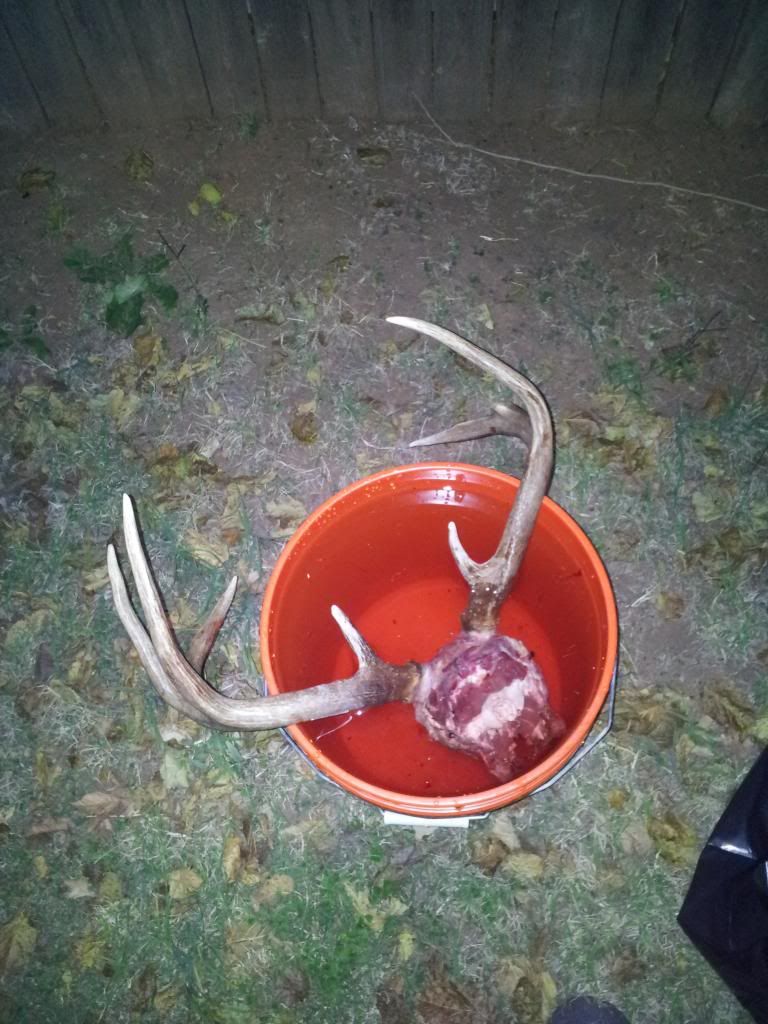
After 24 hours, I pulled the skull out and used a screwdriver to remove as much of the brain as possible. The brain has started to liquefy, but the outer casing of the brain, if you will, is still somewhat attached.
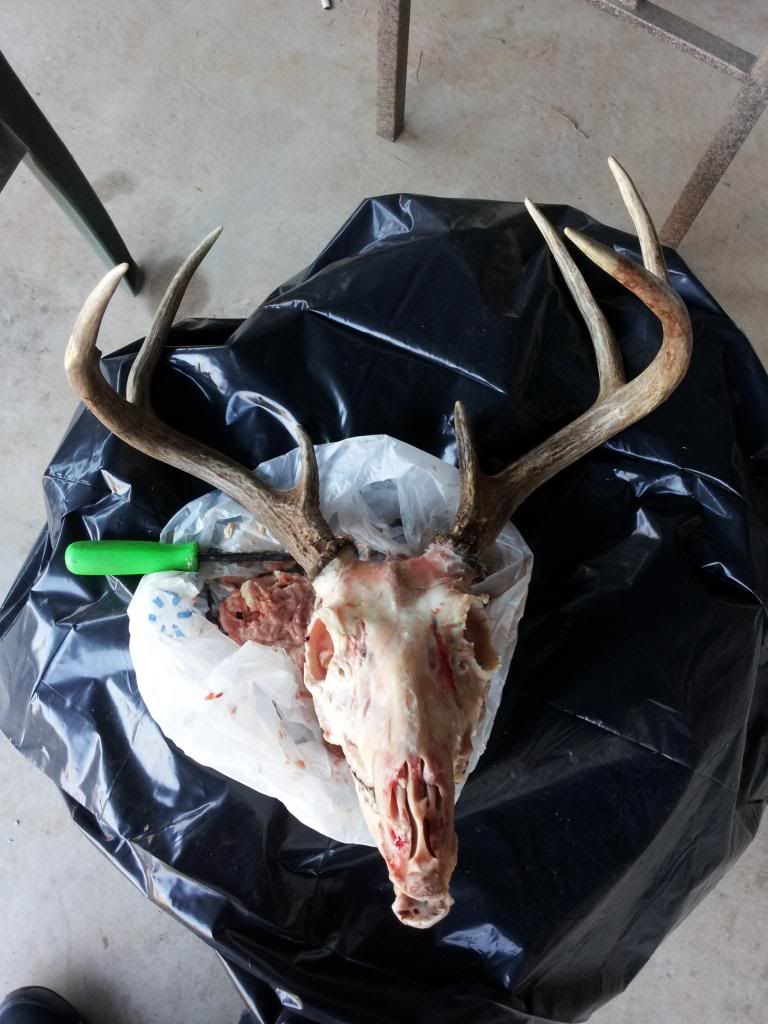
I soaked him for another 24 hours before getting my wife out of the house so I could start boiling the skull. I filled the pot with water, placed the skull in, then set the burner to high. At this point, I added a few drops of dawn dish soap to help with the smell that I knew would occur but also to help cut the grease and fat off the skull. Upon review, I would suggest covering the bases of the antlers in saran-wrap and aluminum foil to prevent the darkening that occurs as the boiled water soaks the antlers. Also, wrap the section of the antler that will touch the pot in aluminum foil to prevent the direct contact with the heat. If the antlers are not large enough to hold them out of the water, use a wire hanger, and gently wrap it around the antler bases then attach it to the handles on the outside of the pot to hold it up.
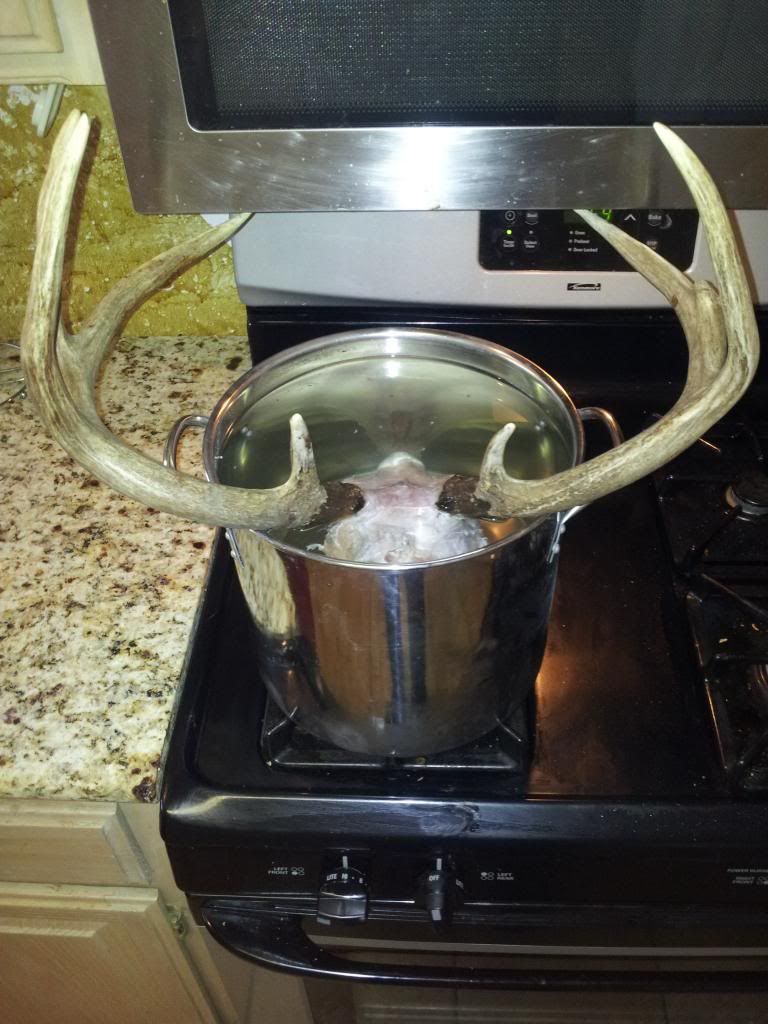
After an hour, the water finally started boiling. I turned it down a bit as I wanted a slow boil. There was some random junk that had started to float, so I skimmed it out with a fork. Another hour later, I added about two cereal bowls full of water to maintain the water level. The water will start to boil again in about 5 minutes.
After 3 hours of boiling you could tell stuff was loosening off the bone and I used the fork to pull some of it away. 3 hour mark:

After 4 hours, I pulled the pot off the burner and headed for the garage. 4 hour mark:
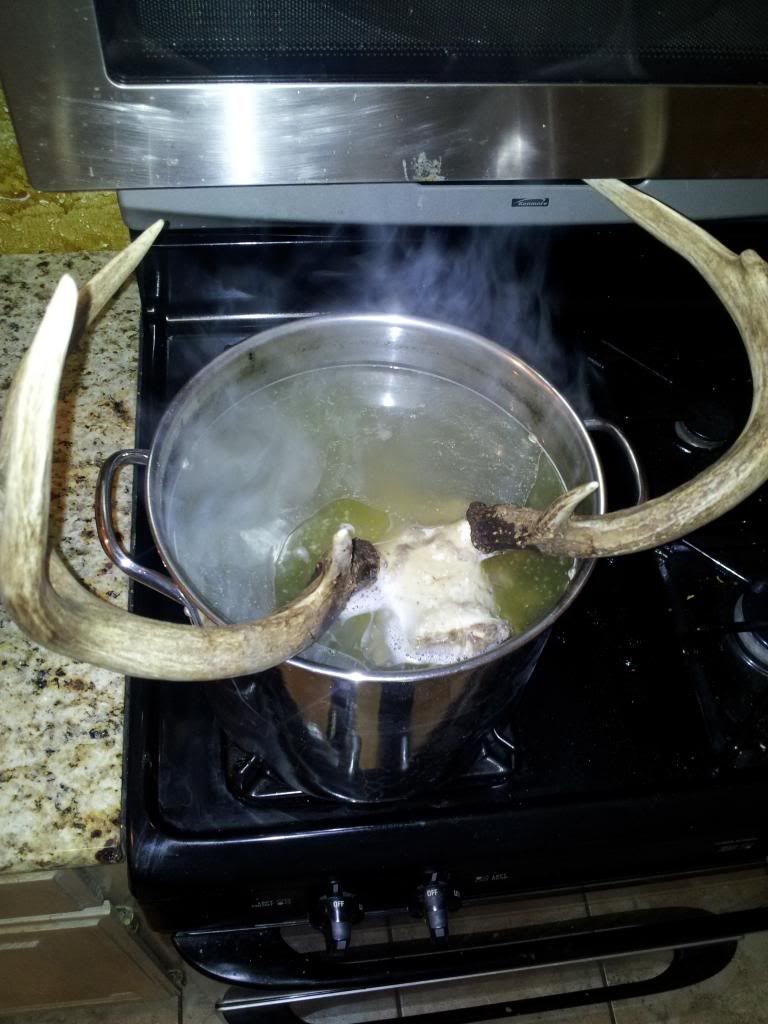
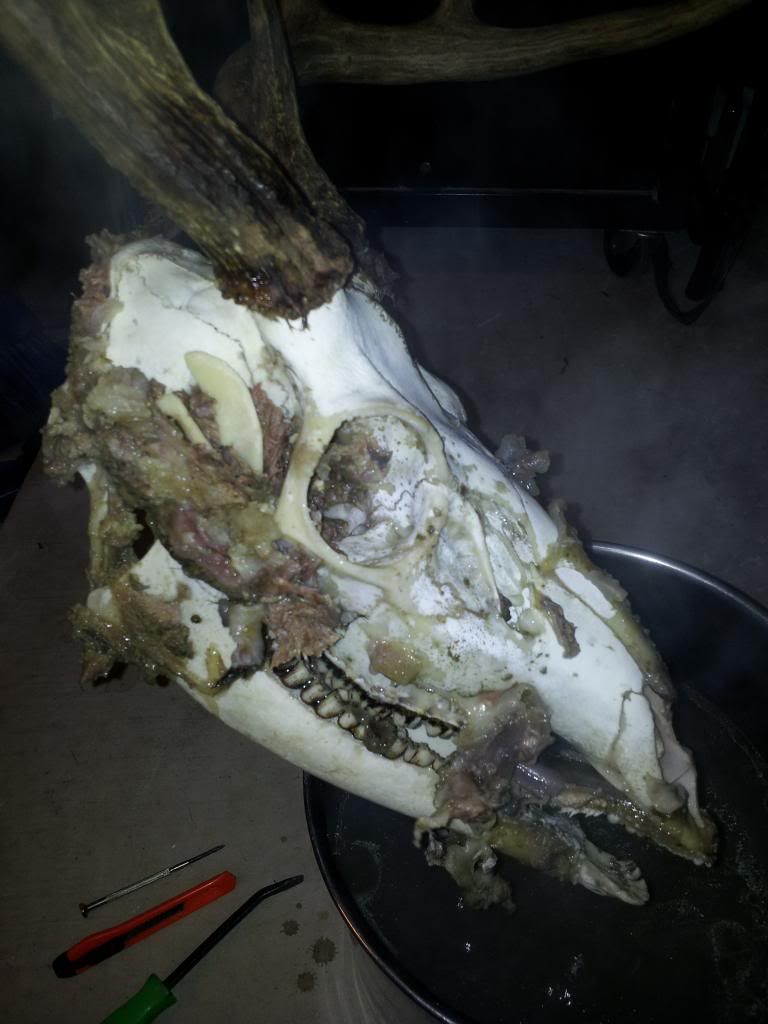
I disconnected the lower jaw to get it out of the way and used a flat-head screwdriver, needlenose pliers, and an exacto knife to start pulling/peeling/cutting away the meat and whatnot. The fork came in handy for the larger chunks in gently pulling them away from the bone. The pliers and screwdriver helped in clearing the brain cavity pretty well. After about an hour, I am left with this:

As it was getting late, I placed the skull back in the 5 gallon bucket overnight to keep it from drying out.
The next night, I boiled the skull for another 4 hours, again with some dish soap. I picked away quite a bit after the two hour mark. Here are some pictures after the second boil.
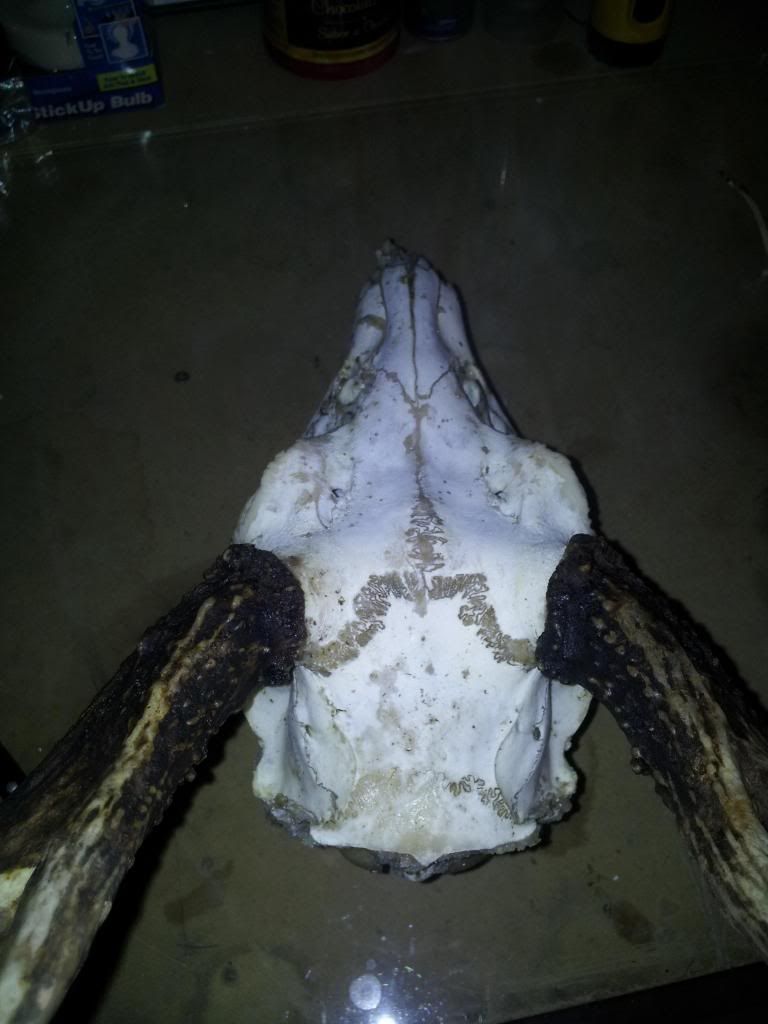
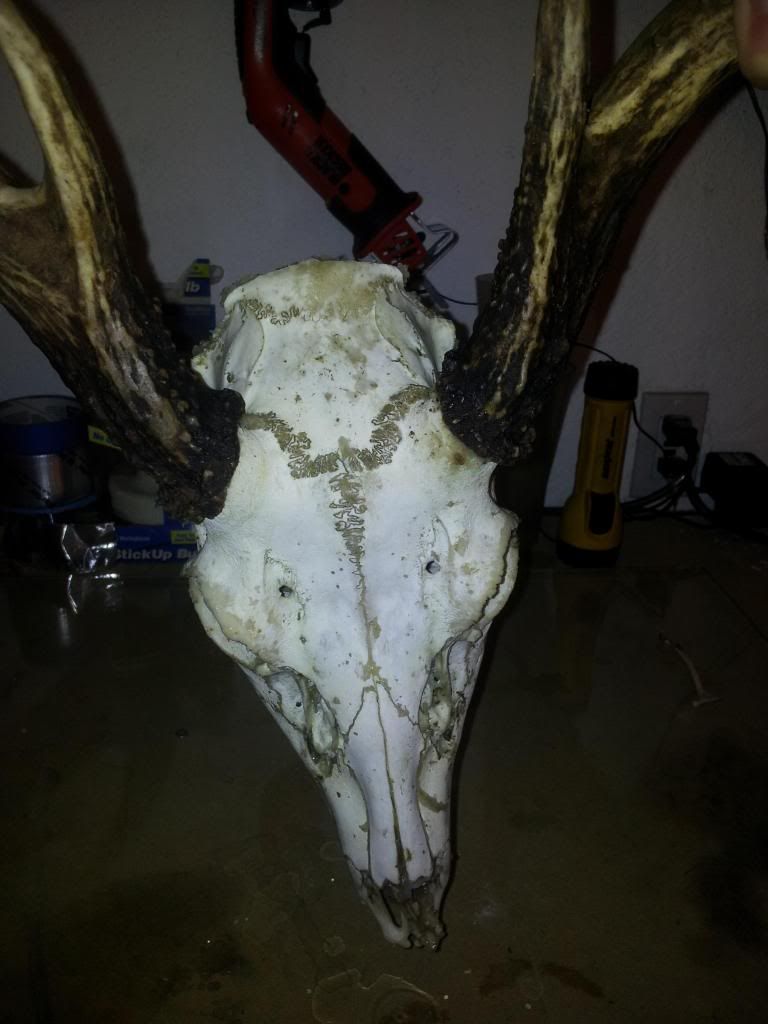
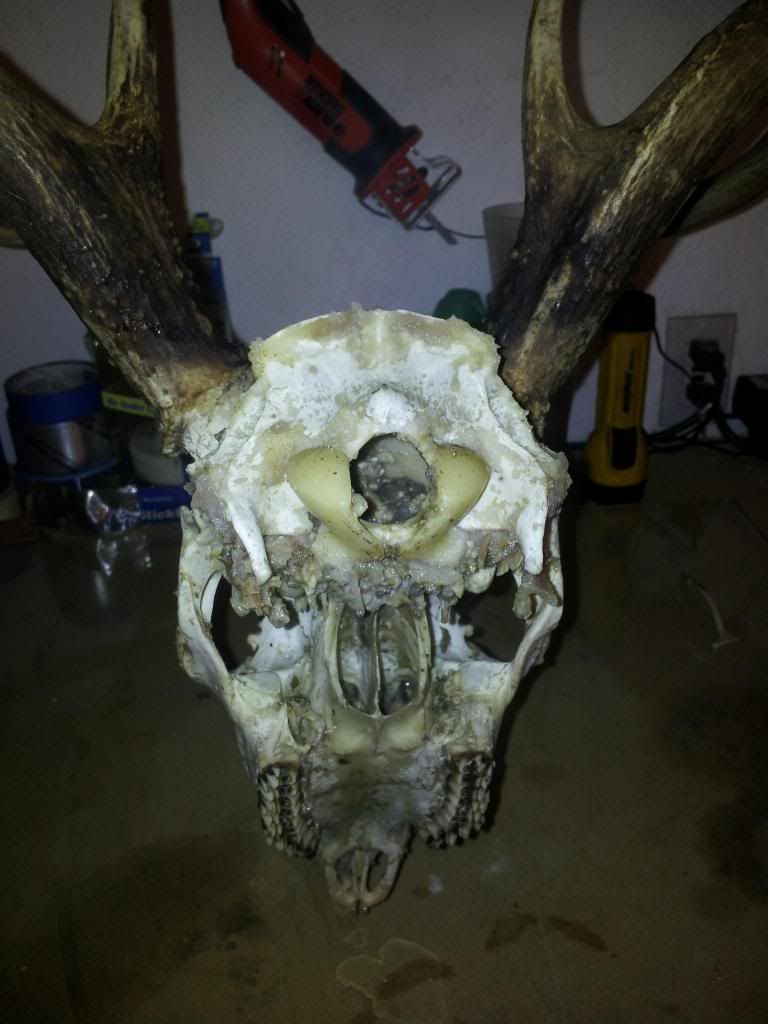
I picked away for about 10 minutes with needle-nose pliers and those mini-screwdrivers you need all of once a year if you don't wear glasses. I hooked up the garden hose and use the "jet" setting on the nozzle. I proceeded to bathe myself and the skull as the contours would redirect water right at me, but it was warm last night, so no big deal. While spraying, focus on the brain cavity and hold the nose up. This will allow you to pull out the remaining parts of the brain with the needle-nose pliers. I probably sprayed the skull down for 15 minutes making sure I caught every part. The most difficult area to clean out was the nasal cavity like I expected. The nasal cartilage in the center of the nose needs to be removed (see pics for how it should look after it is removed). The cartilage and meat go so far back that it's impossible to get out with tools. This is why I started spraying the skull within 15 minutes of pulling it out of the boiling water, as the cartilage and meat were still very pliable. Spraying into the nasal cavity from below the skull (the opening in the roof of the mouth) while loosening what I could through the entrance of the nasal cavity where the nose was with pliers. Eventually the bits should slide out of the nose intact.
After spraying, I spent another 20 or so minutes picking at the skull to remove any remnants that could eventually rot/smell/etc. Now is the time to go over the entire skull and check for any remaining meat.
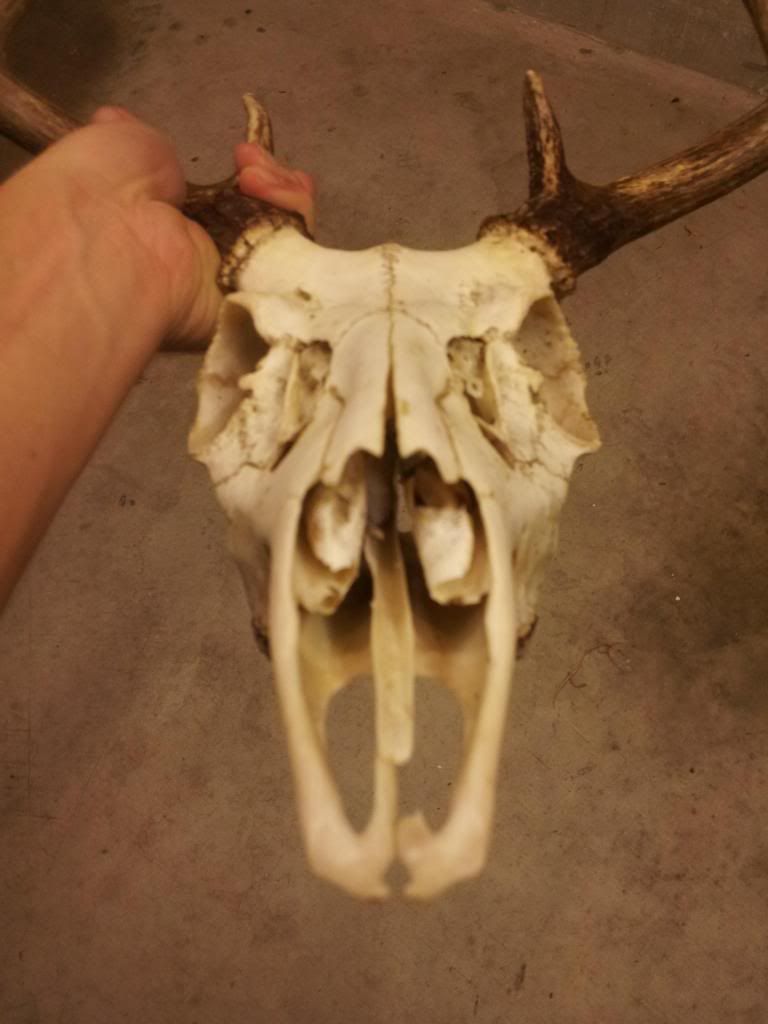
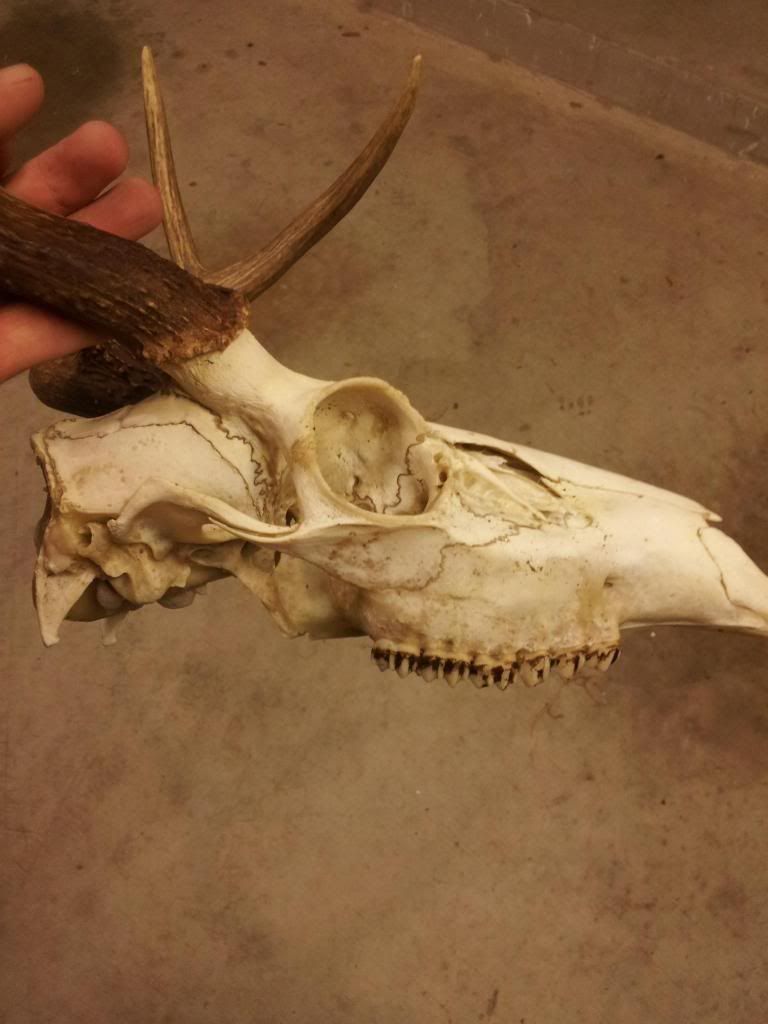
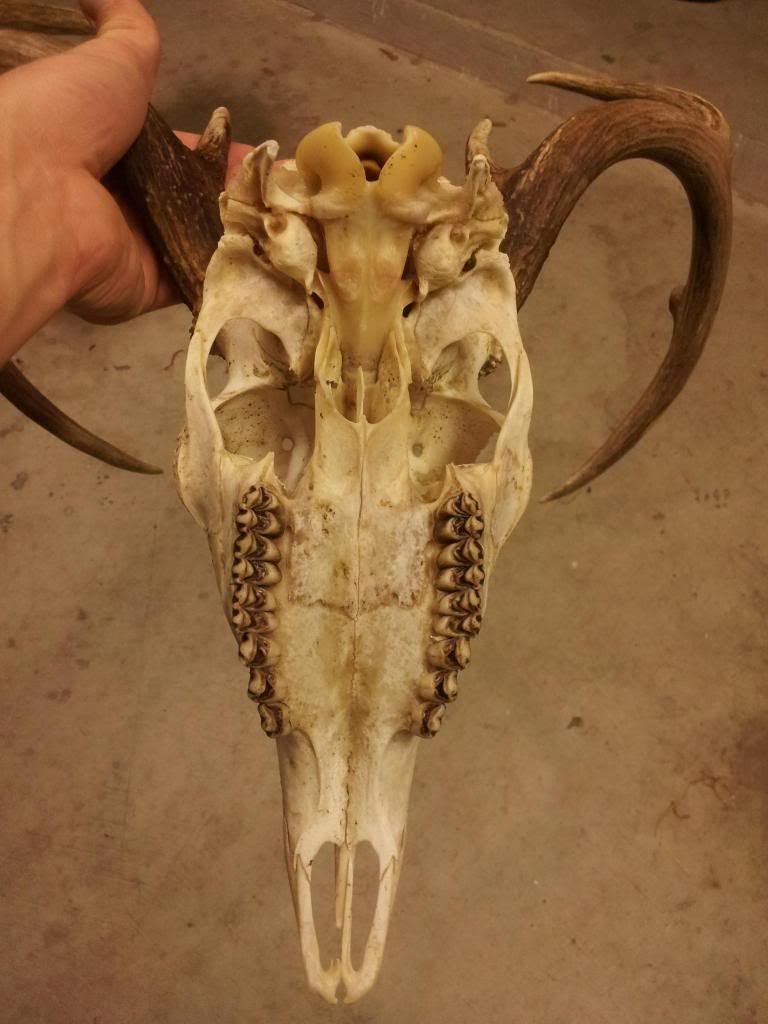
Ready for the peroxide bath:
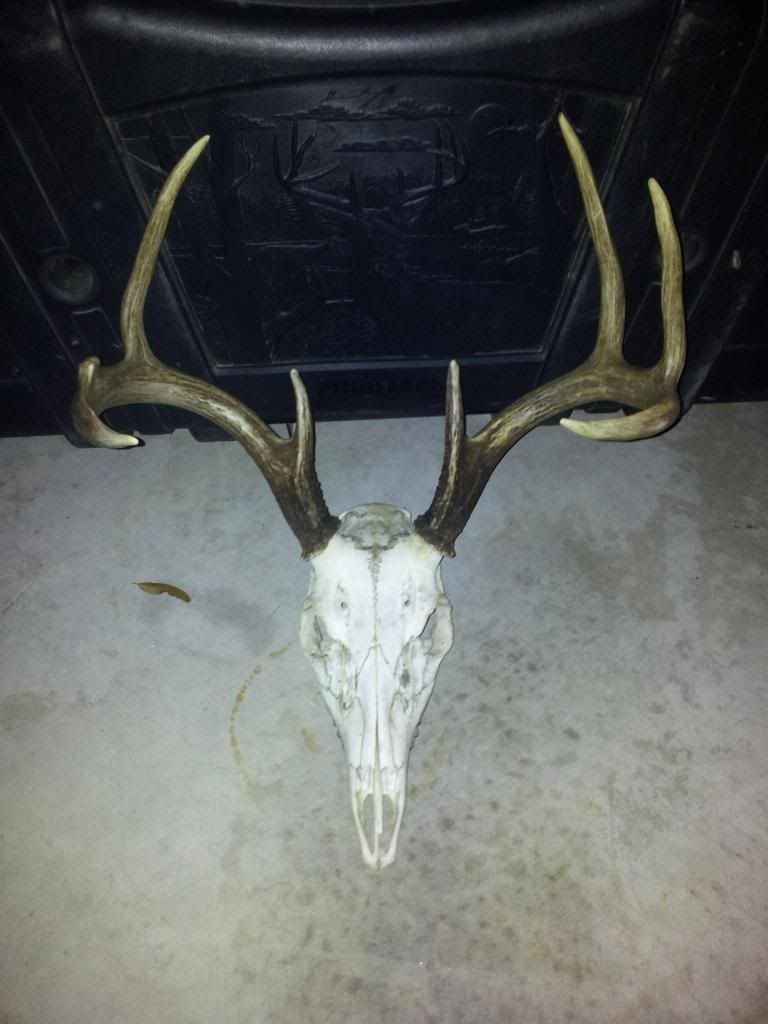
Here's a tip, make sure the container you are going to use doesn't leak before dumping in the peroxide. Be very careful of the level of the peroxide as it will bleach the antlers. You can again use saran wrap around the bases of the antlers and secure it with tape if you want to be very sure not to get the peroxide on them. I used 2 of the larger bottles of peroxide and added water to bring the level to just below the antlers. Every few hours, I would take a paint brush, dunk it in the peroxide, and lightly brush the top of the skull that was not submerged. Be careful not to use much pressure on the brush as it will splatter peroxide onto the antlers and your clothes.
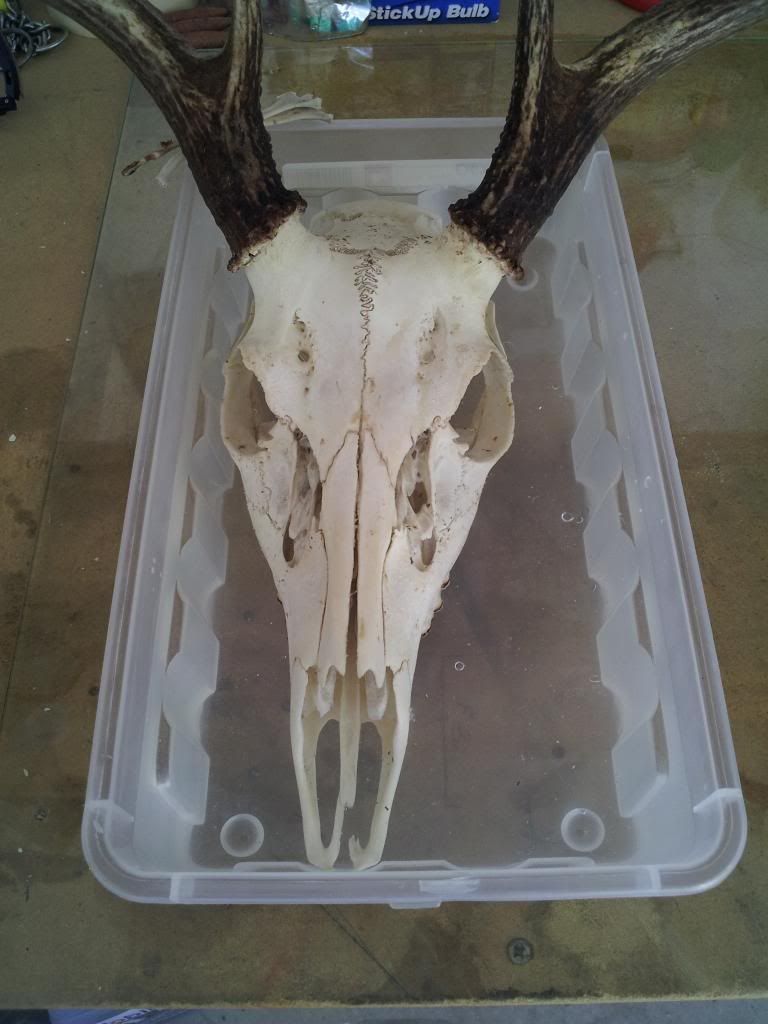
I pulled him out of the peroxide after 24 hours and think I'm good with calling him complete besides brushing his teeth.
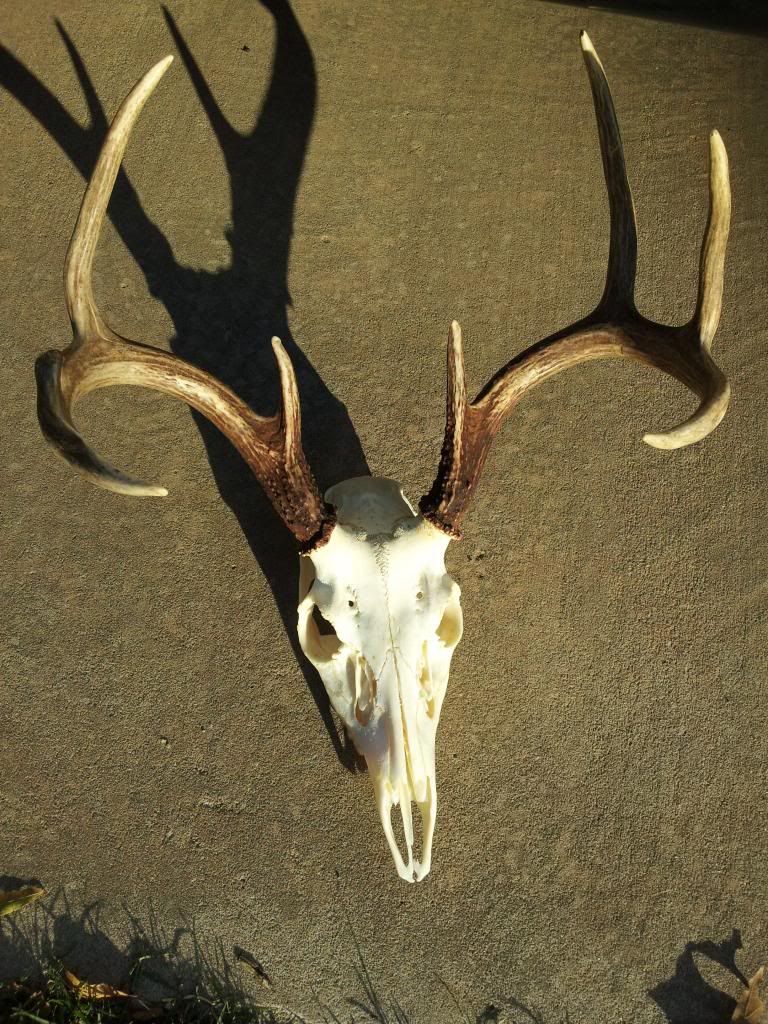


I started by skinning the head within a few hours of the kill. With the muscles and skin still warm, it was pliable and much easier to work with and remove. I used a filet knife to help skin it out. The nose area is tricky as it's mostly cartilage and easily cut. The same with the eye sockets, so be careful what you trim. I nicked mine up pretty good as I was a bit too aggressive with the trimming. The eyeballs are a pain, but with a screwdriver, you can ease them out a bit, then make your cuts around them with the filet knife to remove them. The more meat that is removed now will make your life easier later.
After skinning the head.

I filled a 5 gallon bucket with just tap water and soaked the skull for 24 hours.

After 24 hours, I pulled the skull out and used a screwdriver to remove as much of the brain as possible. The brain has started to liquefy, but the outer casing of the brain, if you will, is still somewhat attached.

I soaked him for another 24 hours before getting my wife out of the house so I could start boiling the skull. I filled the pot with water, placed the skull in, then set the burner to high. At this point, I added a few drops of dawn dish soap to help with the smell that I knew would occur but also to help cut the grease and fat off the skull. Upon review, I would suggest covering the bases of the antlers in saran-wrap and aluminum foil to prevent the darkening that occurs as the boiled water soaks the antlers. Also, wrap the section of the antler that will touch the pot in aluminum foil to prevent the direct contact with the heat. If the antlers are not large enough to hold them out of the water, use a wire hanger, and gently wrap it around the antler bases then attach it to the handles on the outside of the pot to hold it up.

After an hour, the water finally started boiling. I turned it down a bit as I wanted a slow boil. There was some random junk that had started to float, so I skimmed it out with a fork. Another hour later, I added about two cereal bowls full of water to maintain the water level. The water will start to boil again in about 5 minutes.
After 3 hours of boiling you could tell stuff was loosening off the bone and I used the fork to pull some of it away. 3 hour mark:

After 4 hours, I pulled the pot off the burner and headed for the garage. 4 hour mark:


I disconnected the lower jaw to get it out of the way and used a flat-head screwdriver, needlenose pliers, and an exacto knife to start pulling/peeling/cutting away the meat and whatnot. The fork came in handy for the larger chunks in gently pulling them away from the bone. The pliers and screwdriver helped in clearing the brain cavity pretty well. After about an hour, I am left with this:

As it was getting late, I placed the skull back in the 5 gallon bucket overnight to keep it from drying out.
The next night, I boiled the skull for another 4 hours, again with some dish soap. I picked away quite a bit after the two hour mark. Here are some pictures after the second boil.



I picked away for about 10 minutes with needle-nose pliers and those mini-screwdrivers you need all of once a year if you don't wear glasses. I hooked up the garden hose and use the "jet" setting on the nozzle. I proceeded to bathe myself and the skull as the contours would redirect water right at me, but it was warm last night, so no big deal. While spraying, focus on the brain cavity and hold the nose up. This will allow you to pull out the remaining parts of the brain with the needle-nose pliers. I probably sprayed the skull down for 15 minutes making sure I caught every part. The most difficult area to clean out was the nasal cavity like I expected. The nasal cartilage in the center of the nose needs to be removed (see pics for how it should look after it is removed). The cartilage and meat go so far back that it's impossible to get out with tools. This is why I started spraying the skull within 15 minutes of pulling it out of the boiling water, as the cartilage and meat were still very pliable. Spraying into the nasal cavity from below the skull (the opening in the roof of the mouth) while loosening what I could through the entrance of the nasal cavity where the nose was with pliers. Eventually the bits should slide out of the nose intact.
After spraying, I spent another 20 or so minutes picking at the skull to remove any remnants that could eventually rot/smell/etc. Now is the time to go over the entire skull and check for any remaining meat.



Ready for the peroxide bath:

Here's a tip, make sure the container you are going to use doesn't leak before dumping in the peroxide. Be very careful of the level of the peroxide as it will bleach the antlers. You can again use saran wrap around the bases of the antlers and secure it with tape if you want to be very sure not to get the peroxide on them. I used 2 of the larger bottles of peroxide and added water to bring the level to just below the antlers. Every few hours, I would take a paint brush, dunk it in the peroxide, and lightly brush the top of the skull that was not submerged. Be careful not to use much pressure on the brush as it will splatter peroxide onto the antlers and your clothes.

I pulled him out of the peroxide after 24 hours and think I'm good with calling him complete besides brushing his teeth.

Sunday, November 11, 2012
Mature Public Land Buck Down
November 4th, Matt and I decided to hunt out of the same tree for filming purposes. As we headed to our area, we couldn't decide where to sit. The fact that the sky was turning blue pushed us to our closest stand. The tree is pretty small in diameter, so Matt hooked his climber up and went as high as he could, I followed suit and had mine directly below his where I could stand and not hit his foot platform. This only put me 10 feet off the ground. I had set out 3 scent canisters with doe estrous hoping to draw in a buck looking for an early doe. The wind was out of the northwest and the temperature was around 38 degrees.
Shortly after shooting light, I saw movement to our south. I couldn't tell if it was a doe or a buck, so I grunted. Since Matt had already taken a doe during muzzleloader season, I handed him the camera. Neither of us could spot the deer and we spent 20 minutes watching the area for movement. Eventually, we determined the deer had moved off and we started talking. Typically, in this stand, the deer movement happens around 9am, and with the time change, we expected 8am to be the time for deer to move through.
At 7:30, I use my doe bleat. 5 minutes later, a small 8 point came in. Neither of us were going to shoot a smaller buck this year, so we watched as he fed through at 10 yards. The buck walked directly under a scent canister without so much as lifting his head to check it. As he moved off to the south, it seemed as though he got wind of the scent and milled around a bit, but continued to work off to the south. 5 minutes after he disappeared, I bleated 3 times. Matt and I were talking when I looked to the west. There, at 40 yards, was a large buck looking directly at us. I told Matt to not move and get the video camera going, there's a big buck behind him. He whips his head around and sees the buck. Matt tells me he's not filming, but taking a shot with his bow. I replied, "whoever gets the shot first, takes it." The buck works his way through the brush from the west to the southwest, circling our stand. As he's behind a large brush pile, I draw. Matt draws his bow as the buck begins to move again. The buck spots the movement and stops, staring at our tree. What felt like an eternity passed before he continues down the trail. I had previously ranged this shooting lane at 35 yards as it's the same spot I missed a doe 2 weeks prior. I managed to keep my composure, not giving in to buck fever as the buck emerged in the shooting lane. I was lined up, following the buck with my pins on his chest as he walked through the shooting lane. The only thing I forgot was to bleat at him to get him to stop. My brain had quit functioning after I reached full draw. Matt let's out a bleat which snaps me back into reality and the buck stops. My 30 yard pin was high on his chest with the 40 pin near the bottom of his heart. When the buck stopped, I squeezed my release and watch the arrow in take off in slow motion. Life was now playing frame by frame. The arch of the arrow is on target when the sound every bow hunter loves, breaks the silence. THWACK. The fletchings disappear into his chest and he tears off into the thick stuff. I hear Matt say some colorful words about me shooting so quickly as we listen to the buck blazing a trial. "You literally shot him out from underneath me" he says. He circled back to our west, 20 yards further out then where we had originally seen him and his legs started to give out, as did mine. He gets back up, makes two more lunges to the west, and crashes. I lose my composure and set my bow down, getting a firm grip on the stand and what just happened.
A few minutes pass with my gaze set intently on the buck. Matt and I trade verbal jabs and enjoy the moment of success. Successfully killing a large buck with your best friend there to witness it only added to the experience. My composure returns and I lower my bow. After I get my climber removed from the base of the tree, Matt tosses me the video camera. We wait about 15 minutes before going to retrieve my arrow. We find it under a bed of leaves, stained completely red. We look for a blood trial for several minutes, but to no avail. I'm scratching my head as I knew it was a good shot, the arrow is covered in blood, but no trail. We trail deer even when we see them crash to maintain our tracking skills. Not wanting to bust up the area with our scent any more, we go back to our stands and I grab my bow to be safe. As we approach the fallen buck, the dark antlers emerge from the brush and it's apparent he's expired. I set my bow down and grab my trophy. All the hard work before the season to scout, clear stand locations, and go further than the other hunters on public land have culminated into this moment. We guess the buck at 3 1/2 years old and a broken off G3 tine on his right side makes him a large 7 point. He had the remains of a ravaged tree in the base of his antlers and his tarsals were starting to darken. The only blood around was at his mouth. We drag him two hundred yards and gut him. There is a perfect broadhead cut through his left lung, with the right lung decimated. Due to his body size and a slightly high shot, all the blood was held within his chest cavity instead of spilling from the entry and exit wounds. After an extremely long drag, we get him to the truck and make our way to Matt's dad's house to weigh him. Even gutted, he weighed 150 pounds, which is huge for this area of Central Oklahoma. The inside spread of his rack is 14 5/8" with an outside spread of 17".
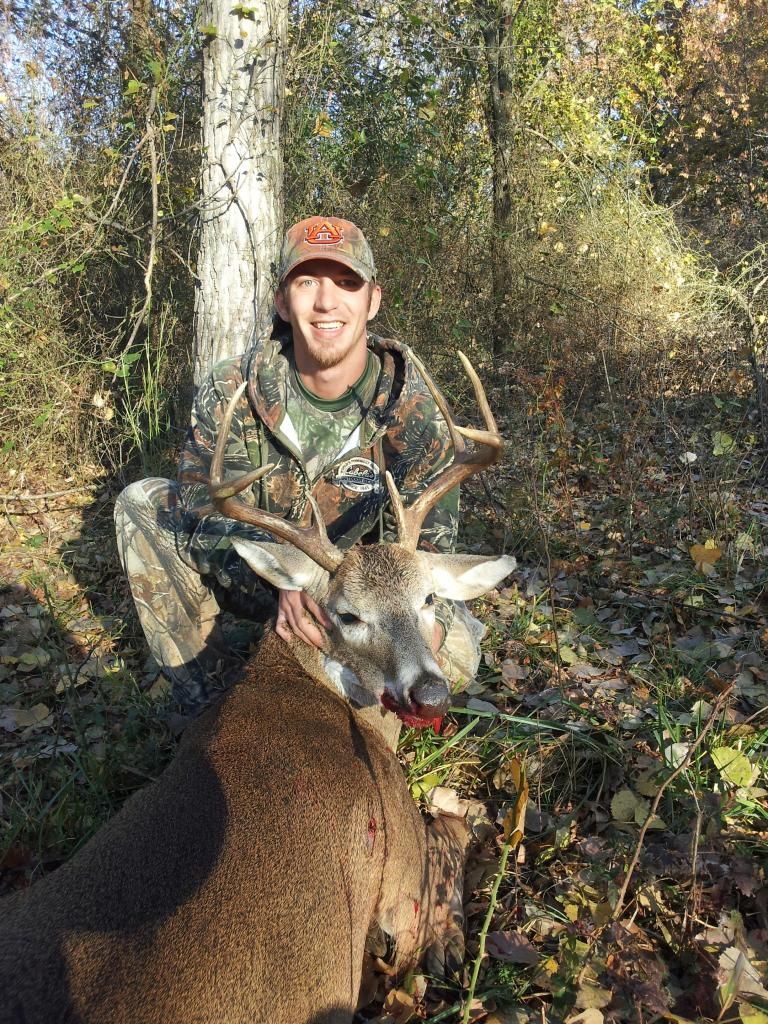

I decided to attempt my own Euro mount of the skull and will have a "how to" writeup posted once completed.
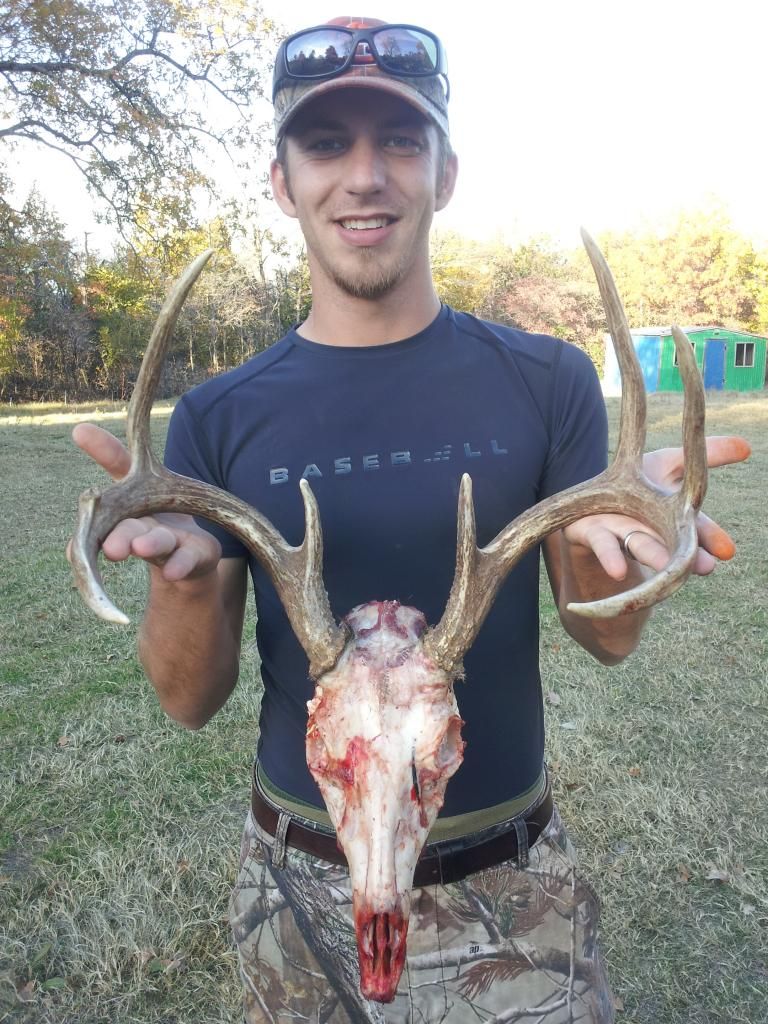
Shortly after shooting light, I saw movement to our south. I couldn't tell if it was a doe or a buck, so I grunted. Since Matt had already taken a doe during muzzleloader season, I handed him the camera. Neither of us could spot the deer and we spent 20 minutes watching the area for movement. Eventually, we determined the deer had moved off and we started talking. Typically, in this stand, the deer movement happens around 9am, and with the time change, we expected 8am to be the time for deer to move through.
At 7:30, I use my doe bleat. 5 minutes later, a small 8 point came in. Neither of us were going to shoot a smaller buck this year, so we watched as he fed through at 10 yards. The buck walked directly under a scent canister without so much as lifting his head to check it. As he moved off to the south, it seemed as though he got wind of the scent and milled around a bit, but continued to work off to the south. 5 minutes after he disappeared, I bleated 3 times. Matt and I were talking when I looked to the west. There, at 40 yards, was a large buck looking directly at us. I told Matt to not move and get the video camera going, there's a big buck behind him. He whips his head around and sees the buck. Matt tells me he's not filming, but taking a shot with his bow. I replied, "whoever gets the shot first, takes it." The buck works his way through the brush from the west to the southwest, circling our stand. As he's behind a large brush pile, I draw. Matt draws his bow as the buck begins to move again. The buck spots the movement and stops, staring at our tree. What felt like an eternity passed before he continues down the trail. I had previously ranged this shooting lane at 35 yards as it's the same spot I missed a doe 2 weeks prior. I managed to keep my composure, not giving in to buck fever as the buck emerged in the shooting lane. I was lined up, following the buck with my pins on his chest as he walked through the shooting lane. The only thing I forgot was to bleat at him to get him to stop. My brain had quit functioning after I reached full draw. Matt let's out a bleat which snaps me back into reality and the buck stops. My 30 yard pin was high on his chest with the 40 pin near the bottom of his heart. When the buck stopped, I squeezed my release and watch the arrow in take off in slow motion. Life was now playing frame by frame. The arch of the arrow is on target when the sound every bow hunter loves, breaks the silence. THWACK. The fletchings disappear into his chest and he tears off into the thick stuff. I hear Matt say some colorful words about me shooting so quickly as we listen to the buck blazing a trial. "You literally shot him out from underneath me" he says. He circled back to our west, 20 yards further out then where we had originally seen him and his legs started to give out, as did mine. He gets back up, makes two more lunges to the west, and crashes. I lose my composure and set my bow down, getting a firm grip on the stand and what just happened.
A few minutes pass with my gaze set intently on the buck. Matt and I trade verbal jabs and enjoy the moment of success. Successfully killing a large buck with your best friend there to witness it only added to the experience. My composure returns and I lower my bow. After I get my climber removed from the base of the tree, Matt tosses me the video camera. We wait about 15 minutes before going to retrieve my arrow. We find it under a bed of leaves, stained completely red. We look for a blood trial for several minutes, but to no avail. I'm scratching my head as I knew it was a good shot, the arrow is covered in blood, but no trail. We trail deer even when we see them crash to maintain our tracking skills. Not wanting to bust up the area with our scent any more, we go back to our stands and I grab my bow to be safe. As we approach the fallen buck, the dark antlers emerge from the brush and it's apparent he's expired. I set my bow down and grab my trophy. All the hard work before the season to scout, clear stand locations, and go further than the other hunters on public land have culminated into this moment. We guess the buck at 3 1/2 years old and a broken off G3 tine on his right side makes him a large 7 point. He had the remains of a ravaged tree in the base of his antlers and his tarsals were starting to darken. The only blood around was at his mouth. We drag him two hundred yards and gut him. There is a perfect broadhead cut through his left lung, with the right lung decimated. Due to his body size and a slightly high shot, all the blood was held within his chest cavity instead of spilling from the entry and exit wounds. After an extremely long drag, we get him to the truck and make our way to Matt's dad's house to weigh him. Even gutted, he weighed 150 pounds, which is huge for this area of Central Oklahoma. The inside spread of his rack is 14 5/8" with an outside spread of 17".


I decided to attempt my own Euro mount of the skull and will have a "how to" writeup posted once completed.

Tuesday, November 6, 2012
Starting to See Some Action
October 21st, Matt and I headed out to a stand we scouted just before the season. None of us have sat in the location. We picked what we expect to be the perfect wind and both climbed the same tree. At daybreak, a flock of crows found an owl not far from us and went crazy. For no less than 30 minutes, we couldn't hardly hear each other talk as the crows scolded the owl. During this time, I spotted a deer coming down the hill toward us from the Southeast. I saw that it was a doe and shortly behind her, another doe appeared. They worked there way toward us and stopped at 40 yards. I could see they were getting antsy, and one flagged and trotted back up hill. A minute later, the second doe followed. We had a South wind at 5mph, but, with the air warming in the morning, and the wind being light, I could guess it was swirling some and the does picked it up. About an hour and a half later, a deer was heading our way from directly south of us. He ended up being a 3-point that offered multiple shot opportunities. I drew on him for practice and held for about a minute. In doing this, it helps me solidify my shot sequence when the opportunity presents itself. The buck fed on acorns at 12 yards for 15 minutes as Matt and I watched. He looked up at us a time or two and went back to feeding. He eventually turned around and retraced his original path as he left.
October 28th Matt was with his Dad muzzleloader hunting near Kansas. I stayed behind and hunted our usual areas with my bow. A cold front moved through and I knew the deer would be on their feet. The first hour and a half were uneventful and the tree rocking in the wind threatened to put me to sleep. Just after 9:00am, I heard something crashing through the woods heading toward me. 2 does explode from the scrub brush and into an opening 40 yards away, nervously looking behind them. I knew what to expect and had my bow ready. The does trotted another 30 yards to the East, but I was focused on where they'd come from. A few seconds pass, and I can make out a figure moving through the woods. A buck emerges on the same trail as the does, again, 40 yards away. He appears to be an 8 point, but slightly basket-racked. I'd imagine he was a two year old due to his size, build, and that he's chasing does early. The does continued off into the woods away from me while the buck finds some low hanging branches to thrash. I watched as he made a scrap, then I grunted at him. Even though he was marking his territory, he looked my way, then turned to follow the does. I grunted again, to no avail. 10 minutes later, I hear footsteps behind me. I turn and see a hunter attempting to "still-hunt" through the woods. I whistle at him and he stops. I wave to let him know I'm there and thankfully he turned around and disappeared the way he'd come. Another hour passes before I spot a doe moving to my Northwest. She eases by at about 45 yards and circles to my South without ever getting closer. As I'm watching her, I notice the same buck is about 80 yards behind her, but again, out of range. I grunted again, and he stops. After a few moments of glaring in my direction, I snort-wheeze. He's not impressed by this and follows the doe out of sight.
Matt successfully harvested a doe while muzzleloader hunting at 60 yards. No larger bucks presented him an opportunity. Mark, Matt's Dad, having already taken 2 does this year, was holding out for a buck. He saw several great bucks, but they were around 200 yards. The next day, he eased into the wood-line within 75 yards of where the bucks had been passing the previous 2 days. A few hours into his hunt, he caught movement in the woods and brought his binoculars up to check the size of the deer. He saw plenty of antler and prepared for the shot. The buck was in a hurry and was not going to slow down. Mark took care in his shot placement and pulled the trigger. The buck took off, but did not make it far before crashing. From looking at his teeth, he appears to be a great 2 year old, possibly a 3 year old.
The bucks are starting to move!
October 28th Matt was with his Dad muzzleloader hunting near Kansas. I stayed behind and hunted our usual areas with my bow. A cold front moved through and I knew the deer would be on their feet. The first hour and a half were uneventful and the tree rocking in the wind threatened to put me to sleep. Just after 9:00am, I heard something crashing through the woods heading toward me. 2 does explode from the scrub brush and into an opening 40 yards away, nervously looking behind them. I knew what to expect and had my bow ready. The does trotted another 30 yards to the East, but I was focused on where they'd come from. A few seconds pass, and I can make out a figure moving through the woods. A buck emerges on the same trail as the does, again, 40 yards away. He appears to be an 8 point, but slightly basket-racked. I'd imagine he was a two year old due to his size, build, and that he's chasing does early. The does continued off into the woods away from me while the buck finds some low hanging branches to thrash. I watched as he made a scrap, then I grunted at him. Even though he was marking his territory, he looked my way, then turned to follow the does. I grunted again, to no avail. 10 minutes later, I hear footsteps behind me. I turn and see a hunter attempting to "still-hunt" through the woods. I whistle at him and he stops. I wave to let him know I'm there and thankfully he turned around and disappeared the way he'd come. Another hour passes before I spot a doe moving to my Northwest. She eases by at about 45 yards and circles to my South without ever getting closer. As I'm watching her, I notice the same buck is about 80 yards behind her, but again, out of range. I grunted again, and he stops. After a few moments of glaring in my direction, I snort-wheeze. He's not impressed by this and follows the doe out of sight.
Matt successfully harvested a doe while muzzleloader hunting at 60 yards. No larger bucks presented him an opportunity. Mark, Matt's Dad, having already taken 2 does this year, was holding out for a buck. He saw several great bucks, but they were around 200 yards. The next day, he eased into the wood-line within 75 yards of where the bucks had been passing the previous 2 days. A few hours into his hunt, he caught movement in the woods and brought his binoculars up to check the size of the deer. He saw plenty of antler and prepared for the shot. The buck was in a hurry and was not going to slow down. Mark took care in his shot placement and pulled the trigger. The buck took off, but did not make it far before crashing. From looking at his teeth, he appears to be a great 2 year old, possibly a 3 year old.
The bucks are starting to move!
Sunday, October 21, 2012
The Beginning of Deer Season
Opening day, I worked through lunch so that I could leave early and get in stand for my first sit of the season. I chose an acorn flat between two ridges on a dry creek bed at the small tract of private land we just gained access to. Apparently we are going to have a great squirrel season as they were all over the flat. The high was 85 and the sit was uneventful, until I started to get down. It was 10 minutes beyond shooting light and pitch black. I lowered my bow, released my safety harness from the tree, and got both feet on the ladder. Then, I hear footsteps and freeze. To my left, I see shadows moving at 30 yards. 3 deer jump the creek heading my way. Although they were only 20 yards away at this time, I could only make out the white hair of their bellies. After 5 minutes, my right calf is cramped and I'm shifting my weight around trying to not blow my cover. Another 5 minutes pass by, and it seemed as though the deer had fed off. I finally reached the ground, picked up my bow, and took 3 steps before I had a deer blow at me from 20 feet away. It caught me off guard and the deer took off. At least it was dark enough that they were unable to see what I was.
The first weekend of deer season was uneventful for Matt and I. Neither one of us saw a deer, however, his dad, Mark, shot two does Sunday Morning with his crossbow. I had two other hunters walk in on my stand by 8:00am Sunday, so I got down and we headed over to help Mark, trail, drag, and gut the does.
This last Sunday, Matt and I sat in our favorite stands which happen to be only 200 yards apart. We rarely see the same deer even with sitting this close. Around 9:00am, two does came crashing through at 30 yards and didn't stop until they were out of site. I wondered if another hunter was about to walk in on my hunt. I wait 15 minutes and hear something coming from the same hillside the previous does left. I spot a doe moving through the brush. Another doe and a spotted fawn follow not far behind. The does were trying to hurry, but the fawn was unable to move at their pace, thus causing the does to be on high-alert. I locate an opening in the direction they are heading and get ready. The first doe bounds through the shooting lane, and as the second attempts the same, I stop her with a bleat. I settle my 30 yard pin on her lungs (she was at 32 yards) and release. The second my bowstring left my release, she double back on her trail and I missed. All 3 deer disappeared into the brush. I felt good about the shot, but knew I missed. After I got out of the stand, I walked my arrow path. I could see where she planted her hooves to spin and found my arrow in line with where her vitals had been. A clean miss, but something that will happen as you bow hunt.
Sunday night we headed to our small section of private land. Matt headed to a ladder stand, Charles sat in his pop-up blind, and I went to the acorn flat. I was still setting up the camera arm on the tree when my phone starts vibrating. Matt is texting me to say a small buck is on his way. As I’m reading the text, the 4-point comes running in, obviously spooked by something. He stops behind my tree at 23 yards, broadside. I’m being picky this year with bucks as you only get two buck tags a season. As he stood there, with my bow still on the ground, I grabbed my gear string and hoisted my bow into the tree, knocked an arrow, put on my release, and drew on him. I held the pins on his vitals, envisioning the shot. He walked through the dry creek bed and left me with a quartering away shot. I continued to hold my pins on him, strictly for mental practice. In doing this on a deer I have no intentions of shooting, it allows my mind to process my shot form, bow is level, breathing, visualizing the vitals and the path of the arrow. In holding this position for about a minute or so, it assists with forming good habits and making them second nature. He eventually walked up the hill and jumped the fence. The buck had come from the west of Matt, and with the wind being northwest, we don’t know for sure what spooked him.
Around 5:30 I hear leaves crunching and notice a skunk making a B-line for my stand. I unintentionally held my breath as he wondered by at 10 feet, then stopped at 20 yards to clean himself. I just let him continue on his merry way. As shooting light fades, I was packed up and about to let my bow down when I heard leaves crunching behind me. It was quite a racket and I expected it to be the does I’d seen opening day around the same time. In the darkness, I spot 4 small bodies heading through the creek. It’s a family of raccoons, with the largest probably being around 20+ pounds. Just like the skunk, they walk to within 10 feet of my stand and start milling around. These critters can be nasty to deal with and one starts eyeballing me. I see the white ring of his face looking in my direction and let an arrow fly. He growls and takes off. It looked like I skewered him. The other 3 coons immediately climb up 3 trees nearby with the closest being 10 feet away. He gets to eye-level and starts staring me down. Bad move. I nock another arrow and send it through his ball of fur. He falls half way down the tree, catches himself, and takes off. Knowing I connected on both of them, I get down and look for the critters. Matt and Charles showed up and we scanned the woods for a minute, but not wanting to leave our scent all over the area, we backed out without finding either coon.
The beginning of the year has been a bit slow thus far. Once the October-lull gives way to the pre-rut in the coming weeks, I'm sure things will pick up.
The first weekend of deer season was uneventful for Matt and I. Neither one of us saw a deer, however, his dad, Mark, shot two does Sunday Morning with his crossbow. I had two other hunters walk in on my stand by 8:00am Sunday, so I got down and we headed over to help Mark, trail, drag, and gut the does.
This last Sunday, Matt and I sat in our favorite stands which happen to be only 200 yards apart. We rarely see the same deer even with sitting this close. Around 9:00am, two does came crashing through at 30 yards and didn't stop until they were out of site. I wondered if another hunter was about to walk in on my hunt. I wait 15 minutes and hear something coming from the same hillside the previous does left. I spot a doe moving through the brush. Another doe and a spotted fawn follow not far behind. The does were trying to hurry, but the fawn was unable to move at their pace, thus causing the does to be on high-alert. I locate an opening in the direction they are heading and get ready. The first doe bounds through the shooting lane, and as the second attempts the same, I stop her with a bleat. I settle my 30 yard pin on her lungs (she was at 32 yards) and release. The second my bowstring left my release, she double back on her trail and I missed. All 3 deer disappeared into the brush. I felt good about the shot, but knew I missed. After I got out of the stand, I walked my arrow path. I could see where she planted her hooves to spin and found my arrow in line with where her vitals had been. A clean miss, but something that will happen as you bow hunt.
Sunday night we headed to our small section of private land. Matt headed to a ladder stand, Charles sat in his pop-up blind, and I went to the acorn flat. I was still setting up the camera arm on the tree when my phone starts vibrating. Matt is texting me to say a small buck is on his way. As I’m reading the text, the 4-point comes running in, obviously spooked by something. He stops behind my tree at 23 yards, broadside. I’m being picky this year with bucks as you only get two buck tags a season. As he stood there, with my bow still on the ground, I grabbed my gear string and hoisted my bow into the tree, knocked an arrow, put on my release, and drew on him. I held the pins on his vitals, envisioning the shot. He walked through the dry creek bed and left me with a quartering away shot. I continued to hold my pins on him, strictly for mental practice. In doing this on a deer I have no intentions of shooting, it allows my mind to process my shot form, bow is level, breathing, visualizing the vitals and the path of the arrow. In holding this position for about a minute or so, it assists with forming good habits and making them second nature. He eventually walked up the hill and jumped the fence. The buck had come from the west of Matt, and with the wind being northwest, we don’t know for sure what spooked him.
Around 5:30 I hear leaves crunching and notice a skunk making a B-line for my stand. I unintentionally held my breath as he wondered by at 10 feet, then stopped at 20 yards to clean himself. I just let him continue on his merry way. As shooting light fades, I was packed up and about to let my bow down when I heard leaves crunching behind me. It was quite a racket and I expected it to be the does I’d seen opening day around the same time. In the darkness, I spot 4 small bodies heading through the creek. It’s a family of raccoons, with the largest probably being around 20+ pounds. Just like the skunk, they walk to within 10 feet of my stand and start milling around. These critters can be nasty to deal with and one starts eyeballing me. I see the white ring of his face looking in my direction and let an arrow fly. He growls and takes off. It looked like I skewered him. The other 3 coons immediately climb up 3 trees nearby with the closest being 10 feet away. He gets to eye-level and starts staring me down. Bad move. I nock another arrow and send it through his ball of fur. He falls half way down the tree, catches himself, and takes off. Knowing I connected on both of them, I get down and look for the critters. Matt and Charles showed up and we scanned the woods for a minute, but not wanting to leave our scent all over the area, we backed out without finding either coon.
The beginning of the year has been a bit slow thus far. Once the October-lull gives way to the pre-rut in the coming weeks, I'm sure things will pick up.
Saturday, September 29, 2012
Pronghorn Draw Hunt - No Easy Task
Back in May, I entered my first draw hunt application. I applied for several of the coveted hunts like elk, but often times, those take decades of preference points to draw, if ever. I looked at the pronghorn options. Two counties offer pronghorn with both buck and doe tags as options. I apply for both buck options and a doe. Pronghorn rifle draw hunts are once in a lifetime draws. Once drawn, you will never have another chance at public land pronghorn with a rifle unless you hunt private land with land-owner tags.
In mid-july, the draw was completed. I checked the site, and had been drawn for the rifle pronghorn doe hunt! I was excited as I have never hunted an animal that solely inhabitted flat-lands where they can see for miles. I made arrangements to travel to the panhandle of Oklahoma for the hunt. I opted to wait until the weekend the season was open to not take as many days off of work.
My wife, 18-month old, and I hit the road at 8:30am. Once you are 2 hours northwest of Oklahoma City, the terrain is flat. You begin to wonder how far you really can see. Then you keep driving another 5 hours. Your definition of flat has been rewritten by this time. We pulled into Boise City, Oklahoma around 3:30 and got settled into the hotel room. There were 3 other hunters in the parking lot cleaning a doe they had just harvested that morning. My confidence is now much higher. After a brief chat with them, I headed to the Rita Blanca WMA to start glassing.
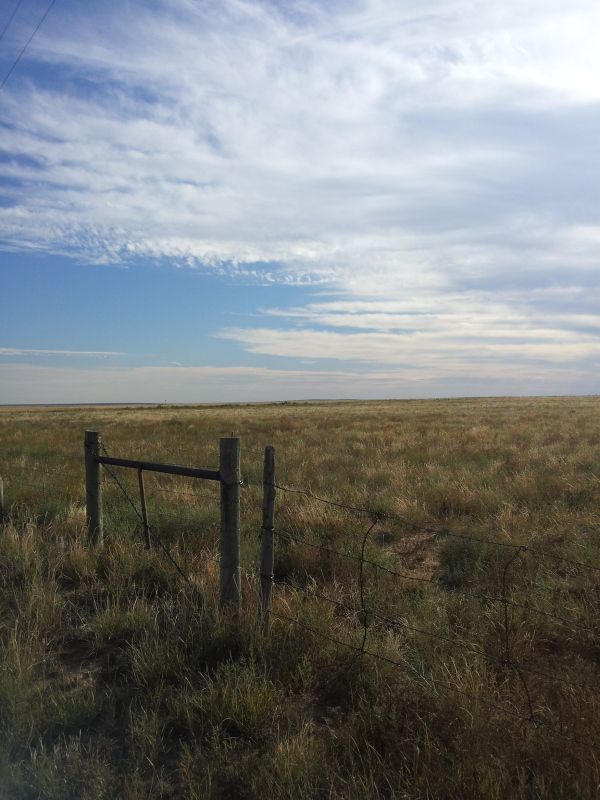
The first 6 units I checked were barren, not even a prairie dog. The Rita Blanca WMA is not one large section, but rather broken down into 30+ sections spread across the entire county. I drove back by one of the units on my way to another area and spotted a group of pronghorn on the horizon. The wind was blowing right to them and by the time I got my rifle and started their way, they showed why they are referred to as "speed goats."

As I arrived at the next section, it was shaped much like a "T" between private land and several hundred acres in size. I spotted two pronghorn heading east from my southwest. I got on all fours and proceeded to crawl 300 yards to a barbed-wire fence to setup for a shot. After trying to avoice cactus, and not always successfully, I was within 200 yards of the buck and doe. I steadied for a shot and double-checked my map. I then realized that the doe I had dead to rights was on private land. It was a disappointment, but a rush as well. As I walked back to my truck, the sun had started to set and I saw a piece of bone 50 yards away. I noticed it was a vertebrae and found several other ribs and leg bones. I then spotted the skull, confirming it was a pronghorn. Closer inspection showed the bases where the horns should have been. As I scoured the area for another 30 minutes I found both horns with one of them being 100 yards from the rest of the skeleton as I was headed to the truck. This had me pretty excited.
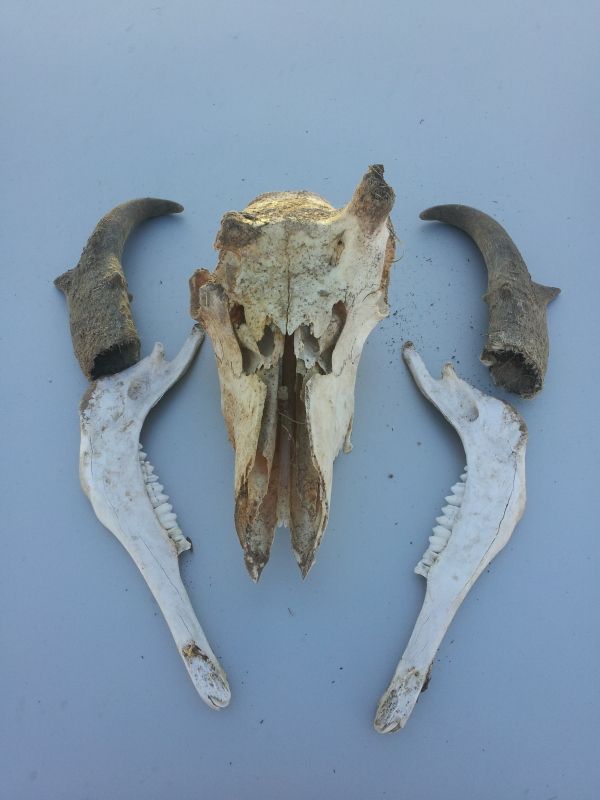

The next morning I head back to this same unit as it had a water tank and I was hoping the pronghorn would wander back by for a drink. I was not expecting the 43 degree temperatures that morning as the forecast showed mid-50's. About 8:30am, I was packing up to warm up in the truck. No pronghorn were within 2 miles and it's rather pointless to sit when pronghorn are not visible while other hunters chase them around.
I had to drive into Texas twice, just to turn around, while glassing the land that Rita Blanca had to offer. I also noticed a bluff appear to my west while checking out unit 102 and 101. The bluff was in New Mexico. By lunch-time on Saturday, I had seen 6 pronghorn and driven 150 miles. Those pronghorn were on a section of private land 400 yards from a very small unit of Rita Blanca. They didn't move more than 100 yards in the 3 hours since I had seen them the first time that morning. I went back to the hotel and picked up my wife and daughter for lunch. We headed to the Rockin' A Cafe there in Boise City. After we ate, I got to talking with the owner. He asked about my luck during the hunt. I told him the pronghorn were scattered and I was unable to even find any on public land that day. He picked up his cell phone and made a couple of calls. A few moments later, he told me to head to Keyes, Oklahoma (about a 20 minute drive) and meet a gentleman by the name of Mr. Stewart. I thanked him and headed to the hotel to grab my gear. My wife wanted to go with me even after I warned that we would most likely be gone for the next 8 hours hunting.
I met Mr. Stewart who provided me a map of all of his land. He must've had 40 different sections scattered across Cimmaron County. He also called a neighbor who owned the land he had just seen a group of pronghorn on and secured permission for me. He said "you'll have a doe dead in 30 minutes" when he got off the phone. I thanked him for giving me permission and rushed to the area. There was a heard of about 15-20 bedded in a field of knee-high milo with 3 standing as sentries. I parked the truck 600 yards from them and started crawling through the field to close the distance. When I got to within probably 350 yards, I noticed several pronghorn standing up and acting skittish. I prepared for a shot, but could not single one out that didn't have another right behind it. When I finally located one by itself, the group took off at a run before I could squeeze the trigger. I dust myself off and watch the heard disappear over a rise. I jump back in the truck only to spot them 2 miles down the road. I had my wife drop me off to start my stalk of them and had her drive around them in an attempt to spook them toward me. Before she could circle them, they took off for another 2-3 mile run. At this point, I decided to try and locate another group. After checking another 10 sections, we ended back near the same group. I parked the truck behind some brush, closed the distance by 400 yards, and estimated they were still at 500 yards. I steadied my bipod and waited for the pronghorn to settle down. I place the crosshairs roughly 2 1/2 feet over the back of a large doe and fired. A cloud of dust kicked up 100 yards short and they didn't stop for probably 5 miles.
As we continued to drive, I spotted a lone doe in a field. I was able to get up on the fence post for a rest. I estimated her to be at 250 yards, then she trotted another 50. When she stopped, I placed the crosshairs a foot over her and fired. Another dirt clod was misted. It was at this point I knew my scope had taken a lethal knock at some point. The scope rings were still tight and the scope was wiggle-free.
At another property, about two hours later, we spotted another group of about 15. My wife drove behind an oil rig and dropped me off before she drove off to keep their attention on her. I kept the rig between them and I and got to within 200 yards. I thought "this is it, I'm going to make it happen finally." I see one doe poke her head around the oil rig so I sit down, prop up my leg, throw the sling around my elbow, and get ready. As the heard steps out, I settle on a doe, place the crosshairs behind her shoulder and pull the tripper. Another dirt clod is sent to heaven. As the pronghorn trott off, I reload and fire twice more at the slowest doe, each time killing dirt successfully.
We spend another 2 hours trying to get shots on this group, who had by that time joined 30 more pronghorn, making it impossible to get anywhere near them. Just as we were about to head back to the hotel for the night, I spot a pronghorn not 100 yards off the road. I pull the truck over, jump out, slide into the ditch, and get ready to fire. I double-check the head only to see antlers that were previously hidden by the ears and a black patch on it's cheek, confirming it is a buck. Going from fever to let down in 5 seconds is a harsh reality at the end of a long day of chasing pronghorn.
The owner of the diner had told me to come back on Sunday morning if I wasn't able to harvest one. Sunday morning, at 7:30 like he had said, I was there drinking a coffee. The farmer that he had arranged for me to meet with didn't show up. I figured I would head back to Mr. Stewart's land and try one more time as the drive home is 7 hours and I wanted to be home by dinner. As I was getting ready to leave, the owner tells me to jump in his truck and we'll go look around. We hit all the land he has access to for about 2 1/2 hours, before seeing a lone doe at the last spot. He slowed down and I jumped into a ditch and took cover near a fence line. Just as I settled my scope, she started to trot. I didn't feel comfortable with taking the shot. With that, I watched my last chance at a pronghorn disappear out of range.
Although I had a wonderful meal of tag soup, the experience was great. Hunting big game in the west is a whole different game and something I'm interested in trying again, but for now, bring on deer season.
Saturday, August 18, 2012
Bowfishing With Underwater Camera Angles
We went bowfishing again last week but we took the bronco this time and utilized the 4 wheel drive to go about 6 miles downstream. We were able to find a whole pool of drum and carp thanks to the guidance of some local guys on 4-wheelers. The pool seemed really clean when looking down into it with polarized glasses, but once the camera was put in it, you could not see nearly as well as we thought. The difference between looking down into the water with the sun and looking across the water is pretty big, but we got some usable footage. Last weeks fish total: 23.
Labels:
4wd,
bow,
bowfishing,
carp,
drum,
fish,
happen,
it,
make,
mihoutdoors,
oklahoma,
outdoors,
river,
underwater,
video
Sunday, August 12, 2012
Releasing a Great Blue Heron While Bowfishing
Last week found us returning to the same spots on the river for bowfishing. The fish were a bit scarce and the headcam wasn't aimed correctly, so we didn't end up with a lot of footage.
During the trip, we notice something struggling along the bank of the river. A great-blue heron was tangled in some twine left behind on a tree branch. Matt carefully freed the bird as we recorded the incident.
We also managed to locate a carp that was hit a week prior, but not retrieved.
During the trip, we notice something struggling along the bank of the river. A great-blue heron was tangled in some twine left behind on a tree branch. Matt carefully freed the bird as we recorded the incident.
We also managed to locate a carp that was hit a week prior, but not retrieved.
Labels:
bow,
bowfishing,
carp,
drum,
fish,
fishing,
happen,
heron,
it,
make,
mihoutdoors,
oklahoma,
outdoors,
river,
video
Wednesday, August 1, 2012
First Try at Bowfishing
With the high temperature during the day soaring past 100 degrees for 2 weeks now, we've put away the fishing tackle in favor of trying something new, bowfishing. I picked up 3 Game Winner bowfishing arrows with broadheads from Academy and opted out of purchasing a reel as the water we were going to be in was between 6 inches and 3 feet deep. The following video is the result of our first attempt at bowfishing.
Monday, June 25, 2012
Early Morning Fishing Catches a Hog
On Sunday, you may have seen that we got out early to do some fishing. We headed out at 5:45 to grab some minnows and were on our way to some abandoned farm ponds deep in the woods where a new development is being built. It didn't take long for the fish to realize that food was falling from the sky. We had strike after strike on minnows and rooster tails.
Matt tossed in a minnow on a bobber and leaned his pole against a tree. He just bought a new baitcasting reel and had yet to tweak the settings, much less figure out where the drag was. A moment later, his bobber is sucked underwater, his line starts reaching for the middle of the pone, and his pole starts toward the water line. He grabs it and sets the hook, but the drag continues to sing. He's unable to reel due to the lack of drag and uses his thumb as a stop on the spool. It was about this time that I started filming with my phone. The bass breaches the surface and shows it's size. We both are shocked. With Matt being unable to reel, he reverts back to his 4 year old ways and starts backing away from the water. As the fish gets closer to the bank, it heads for some tree branches in the water. I quickly grab the line and guide it back to the open water and the bank. I lip the bass and am struck by the shear size of this old pond bass. Matt and I don't ever strictly bass fish, so this thing is a monster to us. We set it on a stringer for about 3 hours as we continued to fish, then it took us 45 minutes to find a fish scale. By this time, the big bass had lost considerable weight and started to dry up. The "dry" weight was over 5 pounds with a length of 21 inches. I can only imagine how much weight was lost prior to our weighing it.
Matt tossed in a minnow on a bobber and leaned his pole against a tree. He just bought a new baitcasting reel and had yet to tweak the settings, much less figure out where the drag was. A moment later, his bobber is sucked underwater, his line starts reaching for the middle of the pone, and his pole starts toward the water line. He grabs it and sets the hook, but the drag continues to sing. He's unable to reel due to the lack of drag and uses his thumb as a stop on the spool. It was about this time that I started filming with my phone. The bass breaches the surface and shows it's size. We both are shocked. With Matt being unable to reel, he reverts back to his 4 year old ways and starts backing away from the water. As the fish gets closer to the bank, it heads for some tree branches in the water. I quickly grab the line and guide it back to the open water and the bank. I lip the bass and am struck by the shear size of this old pond bass. Matt and I don't ever strictly bass fish, so this thing is a monster to us. We set it on a stringer for about 3 hours as we continued to fish, then it took us 45 minutes to find a fish scale. By this time, the big bass had lost considerable weight and started to dry up. The "dry" weight was over 5 pounds with a length of 21 inches. I can only imagine how much weight was lost prior to our weighing it.
Thursday, June 21, 2012
2012-2013 Oklahoma Hunting Regulations Available Online
Although only in draft form, the 2012-2013 Oklahoma Hunting Regulations are now available online. They have a section dedicated to the changes for this season which are worth looking at to avoid any possible issues in the field this year. You can view them here: 2012-2013 Oklahoma Hunting Regulations
Saturday, June 16, 2012
The Rate of Growth of Flathead Catfish
I found a great resource online recently that has a lot of material from Oklahoma state biologists dating back to 1921. Over the next few blogs, we'll be posting up some information from those resources. All rights reserved and credit goes to those Biologists who did the work.
The Rate of Growth of Flathead Catfish
in Twenty-one Oklahoma Lakes
H. A. McCOY, Oklahoma Game and FIsh Department, Norman, 1953
In the computation of average lengths in individual waters, fish were grouped into year-classes and a weighted average was obtained. The simple average of the weighted means for each lake was computed 'to establish the average length at the end of each year of life for the entire sample. On the basis of this sample, flathead catfish average about 4.6 inches at the end of the first year of life, and during the succeeding 13 years attain average lengths of 9.7, 15.2, 20.0, 23.4, 25.9, 28.9, 32.4 35.1, 38.3, 39.0, 41.5, 42.8, and 43.3 inches. Corresponding average weights at these lengths (calculated from length-weight formula in later section are approximately 0.03, 0.31, 1.34, 3.28, 5.47, 7.61, 10.88, 15.77,20.48, 27.20, 28.87, 36.32, 39.06, and 40.67 pounds, respectively. The average annual increment of growth in length is approximately flve inches tor the tirst four years of Ufe, three inches during the following six. years, and decreases to about one inch per year by the fourteenth year (Table II, Figure 1). The average annual increment of growth in weight ae~leratea sharply to about five pounds per year by the ninth year of life (Figure 1). On the basis of three-year moving averages the rate of weight increase declines slighUy after the tenth year of Ufe. However, this phenomenon is not typical of large reservoir populations

AGE-GROUP NUMBER OF FISH AVERAGE LENGTH LENGTH RANGE
III 4 18.4 16.9-20.0
IV 3 22.9 21.7-23.5
V 17 27.45 25.6-28.7
VI 4 32.2 30.6-34.3
VII 4 36.2 31.6-38.5
VIII - - -
IX 2 40.5 39.8-41.1
X 3 38.0 33.5-39.0
XI 6 39.5 36.0-46.0
XII 4 45.7 43.0-48.0
XIII 9 44.2 41.2-54.5
XIV 6 44.6 43.1-46.7
XV 5 46.3 41.2-55.5
XVI 4 43.7 37.2-50.5
XVII 1 43.1
XVIII 2 43.2 42.0-44.5
XIX 1 42.0
A 42.0-inch, 19-year-old flathead catfish taken from Boomer Lake was
the oldest individual in the entire sample, and is the oldest individual of
any Oklahoma species on record at the Fisheries Research Laboratory.
The largest flathead catfish represented in the entire sample was 55.5 inches
long and weighed 95 pounds. This 15-year-old individual, taken from
Boomer Lake, has a calculated weight of 91 pounds.
The Length-Weight Relationship of Flathead Catfish in Oklahoma Water.
SIZE INTERVAL No. of AVERAGE TOTAL AVERAGE WEIGHT CALCULATED
(INCHE8) FISH LENGTH (INCHES) (POUNDS) WEIGHT (POUND8)
------
3.0- 4.9 12 4.2 0.03 0.02
5.0- 6.9 20 5.9 0.08 0.06
7.0- 8.9 37 7.9 0.18 0.16
9.0-10.9 33 10.0 0.36 0.34
1l.0-12.9 27 11.9 0.69 0.60
13.0-14.9 36 13.8 0.91 0.98
16.0-16.9 20 15.8 1.37 1.51
17.0-18.9 26 17.9 2.15 2.29
19.0-20.9 17 19.9 3.14 3.23
21.0-22.9 12 22.0 4.25 4.47
23.0-24.9 22 23.8 5.93 5.82
26.0-26.9 26 26.1 7.80 7.77
27.0-28.9 32 27.8 10.16 9.58
29.0-30.9 19 29.9 12.21 12.12
31.0-32.9 14 31.9 15.67 15.05
33.0-34.9 13 33.6 18.26 17.76
35.0-36.9 14 36.1 23.50 22.44
37.0-38.9 14 37.6 25.94 25.60
39.0-40.9 8 39.6 30.07 30.46
41.0-42.9 7 41.7 35.24 35.87
43.0-44.9 11 43.6 40.35 41.43
45.0-46.9 1 45.7 50.00 48.35
Total Number of Fish - 421
The Rate of Growth of Flathead Catfish
in Twenty-one Oklahoma Lakes
H. A. McCOY, Oklahoma Game and FIsh Department, Norman, 1953
In the computation of average lengths in individual waters, fish were grouped into year-classes and a weighted average was obtained. The simple average of the weighted means for each lake was computed 'to establish the average length at the end of each year of life for the entire sample. On the basis of this sample, flathead catfish average about 4.6 inches at the end of the first year of life, and during the succeeding 13 years attain average lengths of 9.7, 15.2, 20.0, 23.4, 25.9, 28.9, 32.4 35.1, 38.3, 39.0, 41.5, 42.8, and 43.3 inches. Corresponding average weights at these lengths (calculated from length-weight formula in later section are approximately 0.03, 0.31, 1.34, 3.28, 5.47, 7.61, 10.88, 15.77,20.48, 27.20, 28.87, 36.32, 39.06, and 40.67 pounds, respectively. The average annual increment of growth in length is approximately flve inches tor the tirst four years of Ufe, three inches during the following six. years, and decreases to about one inch per year by the fourteenth year (Table II, Figure 1). The average annual increment of growth in weight ae~leratea sharply to about five pounds per year by the ninth year of life (Figure 1). On the basis of three-year moving averages the rate of weight increase declines slighUy after the tenth year of Ufe. However, this phenomenon is not typical of large reservoir populations
AGE-GROUP NUMBER OF FISH AVERAGE LENGTH LENGTH RANGE
III 4 18.4 16.9-20.0
IV 3 22.9 21.7-23.5
V 17 27.45 25.6-28.7
VI 4 32.2 30.6-34.3
VII 4 36.2 31.6-38.5
VIII - - -
IX 2 40.5 39.8-41.1
X 3 38.0 33.5-39.0
XI 6 39.5 36.0-46.0
XII 4 45.7 43.0-48.0
XIII 9 44.2 41.2-54.5
XIV 6 44.6 43.1-46.7
XV 5 46.3 41.2-55.5
XVI 4 43.7 37.2-50.5
XVII 1 43.1
XVIII 2 43.2 42.0-44.5
XIX 1 42.0
A 42.0-inch, 19-year-old flathead catfish taken from Boomer Lake was
the oldest individual in the entire sample, and is the oldest individual of
any Oklahoma species on record at the Fisheries Research Laboratory.
The largest flathead catfish represented in the entire sample was 55.5 inches
long and weighed 95 pounds. This 15-year-old individual, taken from
Boomer Lake, has a calculated weight of 91 pounds.
The Length-Weight Relationship of Flathead Catfish in Oklahoma Water.
SIZE INTERVAL No. of AVERAGE TOTAL AVERAGE WEIGHT CALCULATED
(INCHE8) FISH LENGTH (INCHES) (POUNDS) WEIGHT (POUND8)
------
3.0- 4.9 12 4.2 0.03 0.02
5.0- 6.9 20 5.9 0.08 0.06
7.0- 8.9 37 7.9 0.18 0.16
9.0-10.9 33 10.0 0.36 0.34
1l.0-12.9 27 11.9 0.69 0.60
13.0-14.9 36 13.8 0.91 0.98
16.0-16.9 20 15.8 1.37 1.51
17.0-18.9 26 17.9 2.15 2.29
19.0-20.9 17 19.9 3.14 3.23
21.0-22.9 12 22.0 4.25 4.47
23.0-24.9 22 23.8 5.93 5.82
26.0-26.9 26 26.1 7.80 7.77
27.0-28.9 32 27.8 10.16 9.58
29.0-30.9 19 29.9 12.21 12.12
31.0-32.9 14 31.9 15.67 15.05
33.0-34.9 13 33.6 18.26 17.76
35.0-36.9 14 36.1 23.50 22.44
37.0-38.9 14 37.6 25.94 25.60
39.0-40.9 8 39.6 30.07 30.46
41.0-42.9 7 41.7 35.24 35.87
43.0-44.9 11 43.6 40.35 41.43
45.0-46.9 1 45.7 50.00 48.35
Total Number of Fish - 421
Subscribe to:
Posts (Atom)






